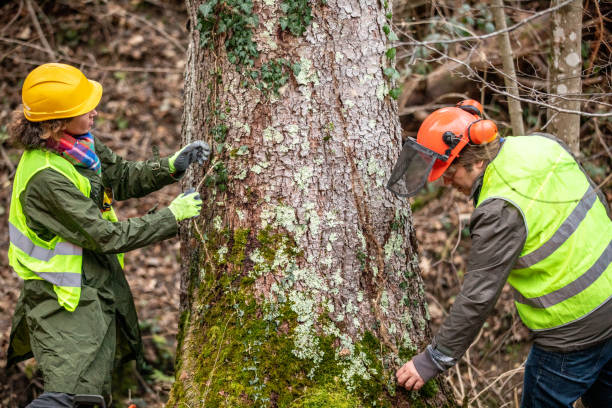Seasonal changes not only affect our wardrobe choices but also significantly impact the health and well-being of the trees around us.
With each season, from the sprouting vitality of spring to the dormant tranquility of winter, comes a unique set of challenges and tasks for maintaining the health of our trees.
Just as we adapt to the changing weather, our trees too need different care strategies to flourish throughout the year.
Understanding these essentials can not only transform your landscape but also enhance your property value.
But, diving into the world of tree care can be overwhelming.
What are the key tasks for each season?
Let’s embark on this journey together to unravel these crucial aspects.
Spring Tree Maintenance Essentials
As the weather warms up and the days grow longer, it’s time to give your trees some much-needed attention.
Spring is the perfect time to revitalize your outdoor space and ensure your trees are healthy and thriving.
Pruning Perfection
- Timing is Key: The best time to prune most trees is late winter or early spring before new growth emerges.
- Cut with Care: Use sharp, clean pruning shears to make precise cuts.
Avoid damaging the bark, as this can lead to disease and insect infestations.
- Remove Dead or Damaged Wood: Prune out any dead, diseased, or crossing branches to improve the tree’s overall health and appearance.
- Shape and Size: You can also use pruning to shape your trees and control their size.
However, avoid heavy pruning, as this can stress the tree.
Fertilize for Growth
- Choose the Right Fertilizer: Select a fertilizer specifically designed for trees.
Look for a balanced formula that provides essential nutrients like nitrogen, phosphorus, and potassium.
- Apply Carefully: Follow the instructions on the fertilizer package.
- Water Thoroughly: After fertilizing, water your trees deeply to help the nutrients reach the roots.
Pest and Disease Prevention
- Inspect Regularly: Keep an eye out for signs of pests and diseases, such as insect infestations, fungal growth, or unusual leaf discoloration.
- Treat Early: If you notice any problems, take action immediately.
- Consider Professional Help: For severe infestations or complex diseases, consult with a certified arborist.
By following these simple tips, you can ensure that your trees remain healthy and beautiful for years to come.
Summer Tree Care Techniques
As the summer heat intensifies, your trees need extra care to stay healthy and vibrant.
Here are some essential tips:
Hydration is Key
- Deep Watering: Water your trees deeply and infrequently, rather than shallowly and often.
- Timing Matters: Water early in the morning or late in the evening to minimize evaporation.
- Mulching Magic: A layer of mulch around the base of your trees helps retain moisture, regulate soil temperature, and suppress weeds.
Pruning for Summer Health
- Remove Deadwood: Prune out any dead or diseased branches to improve the tree’s overall health and appearance.
- Light Pruning: Consider light pruning to remove crossing or rubbing branches, which can damage the tree.
- Avoid Heavy Pruning: Heavy pruning in summer can stress the tree, so it’s best to avoid it unless necessary.
Pest and Disease Control
- Regular Inspection: Keep an eye out for signs of pests and diseases, such as insect infestations, fungal growth, or unusual leaf discoloration.
- Treat Promptly: If you notice any problems, take action immediately.
By following these tips, you can help your trees thrive through the hottest summer months.
Autumn and Winter Tree Protection Strategies
As the seasons change and the temperatures drop, it’s essential to prepare your trees for the harsh winter months.
By taking a few proactive steps, you can help your trees stay healthy and vibrant, even during the coldest weather.
Autumnal Preparations
- Pruning: Late autumn is an ideal time for pruning. Remove any dead, diseased, or damaged branches to improve the tree’s overall health and structure.
- Mulching: Apply a layer of mulch around the base of your trees to help retain moisture, regulate soil temperature, and suppress weeds.
- Watering: Continue to water your trees regularly, especially during dry autumn spells.
Winter Protection Strategies
- Wrapping Young Trees: Protect young trees from harsh winter winds and sunscreens by wrapping their trunks with tree wrap or burlap.
- Snow Removal: While snow can insulate the ground, excessive snow accumulation can damage branches.
- Salt Damage Prevention: If you live in a region where salt is used on roads, be mindful of the potential damage to trees.
By following these tips, you can help your trees weather the winter months and emerge strong and healthy in the spring.
Taking care of your trees throughout the year is a rewarding task that enhances the beauty of your landscape and the health of the environment.
By following these tree care tips for each season, you can ensure your trees are well-equipped to face any challenge they may encounter, whether it’s the blazing summer heat or the freezing winter frost.
Remember, a tree that receives proper care and attention will not only survive but thrive, providing you with a beautiful, serene, and healthy outdoor space all year round.

